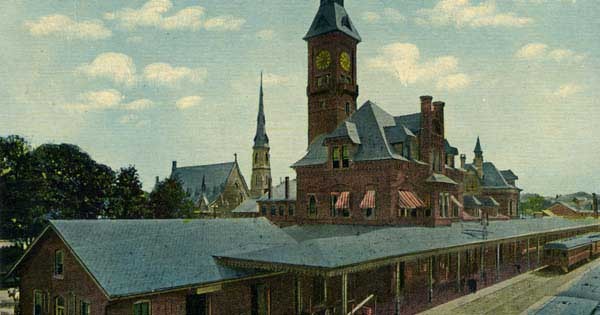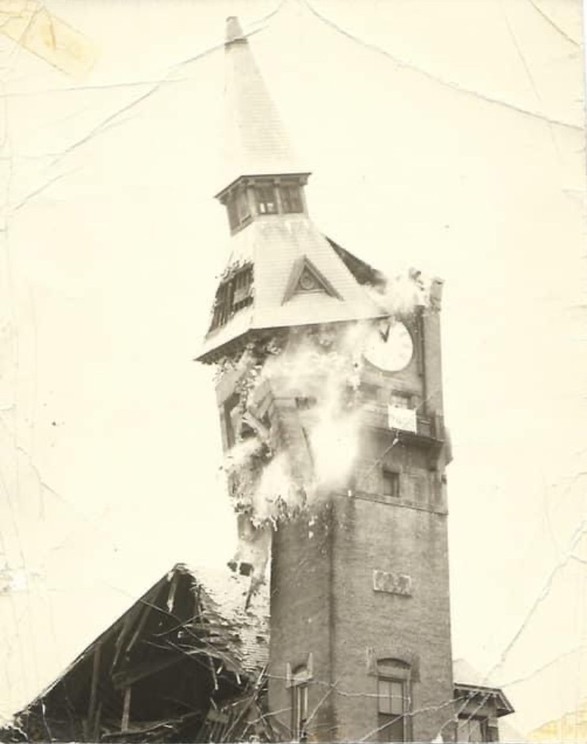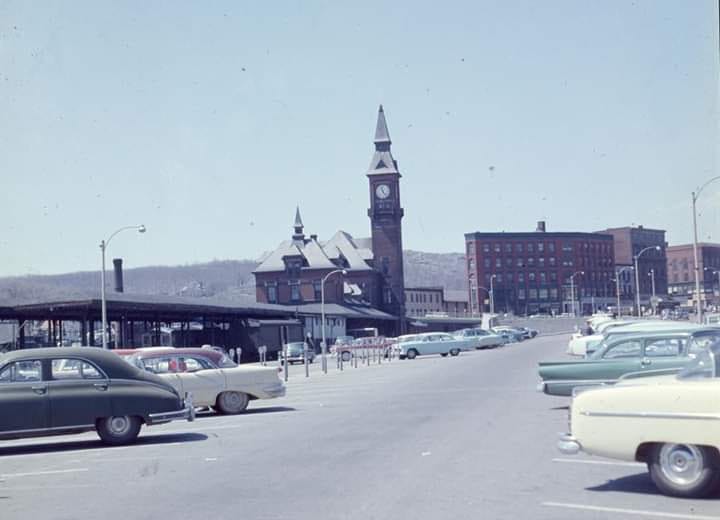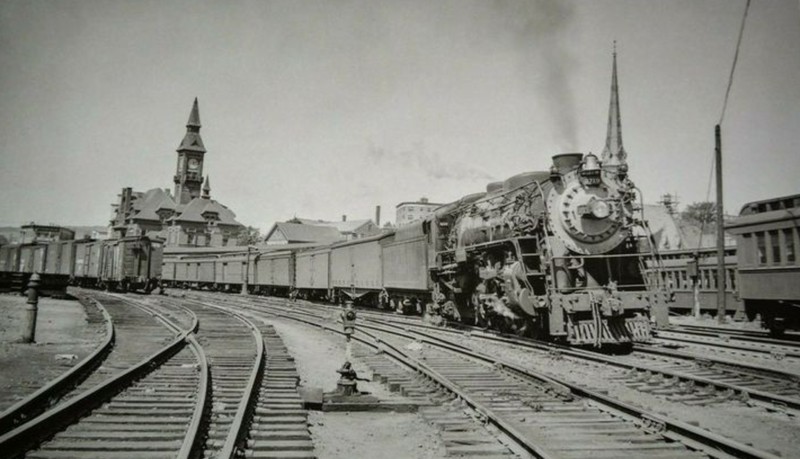The Fitchburg Train Depot
Introduction
Text-to-speech Audio
The current Purple Commuter Line in Massachusetts runs from Wachusett through Fitchburg to the North Station in Boston. It was created this way to make commuter travel more convenient for the people. The history of this line connects to the early railroad construction in the state, in which the Fitchburg Train Deport served as an important hub. The initial construction began in the 1840s and lasted through1870s. Here is the story of the Fitchburg Train Depot.
Images
Fitchburg Railroad from Fitchburg to Vermont

Fitchburg Station Depot (Colorized) back in Fitchburg

Destruction of the train station in 1962.

President Theodore Roosevelt takes the train to visit Fitchburg on September 2, 1902.

Fitchburg Train Depot

A train leaves the depot in the 1950s.

Backstory and Context
Text-to-speech Audio
The Old Fitchburg Depot was constructed in 1842. Alvah Crocker's efforts were vital in bringing the railroad to Fitchburg, and he attended over 100 meetings around the state to advocate for this. However, significant controversy arose over where to build the depot, so much so that enthusiasm for the project declined and the initial opening of the depot met with a more limited celebration. The line initially ran from Fitchburg to Charlestown through 1848. After that year, it was extended to Boston.
The Fitchburg to Boston line was used extensively. By 1887, "the Fitchburg railroad runs eleven passenger trains to Boston every week-day, and five to Greenfield and North Adams." (Fitchburg, MA: Past and Present. pg 20). In total, the depot would see the arrival of over 50 passenger trains per day. One of the lines is known as the Cheshire Railroad (nowadays known as the Cheshire Rail Trail). This railroad ran through Fitchburg and Vermont, more specifically Bellow Falls, Vermont.
The Fitchburg Railroad ran from Fitchburg, MA, to modern-day North Station. It was first added to the Truck Road path in 1876 being the last stop. The stops that the railroad would take would be as follows: Boston, Charleston, Union Square, Somerville, Cambridge, Watertown Junction, Hill's Crossing, Belmont, Waverly, Clematis Brook, Beaver Brook, Waltham, Roberts, Stony Brook, Weston, Silver Hill, Lincoln, Concord, Acton, Littleton, Ayer Junction, Shirley, Lunenburg, Leominster, Fitchburg. The rail would be expanded six years later in 1882 with it now being on the Boston and North Adams trail. The line would start from Boston, go past Fitchburg station, and end up at North Adams.
By 1882, Fitchburg would actually have two train stops, as a second stop was added in West Fitchburg. However, the line continued expanding, this time further westward all the way to North Adams, passing through the possibly haunted Hoosac Tunnel. The rumor about the Hoosac Tunnel was that it was haunted by a few miners who tested explosives and caused a bit of a cave-in.
The downfall of the Fitchburg line was an odd one, to say the least, but would happen within the span of 30 years. The beginning of that would be at the start of the 20th century with the purchase of the Fitchburg Railroad by the Boston and Maine line. Upon further research, the fee that was paid to lease the line is unknown. But after that, it would mainly end up going downhill.
Nowadays, people end up using the Commuter Rail to get from Boston to Fitchburg. That would be on the Purple Line with Fitchburg itself being the 2nd to the last station on the line.
Historical Connections
Theodore Roosevelt is the only president to have visited Fitchburg while being in office, and he arrived via the train depot. He visited in 1902 to give a speech at the Wallace Building. Roosevelt became president after President McKinley was assassinated with a revolver manufactured by, oddly enough, the Iver-Johnson Arms Company in Fitchburg (Images of Fitchburg, Page 127.)
The trains passing through the Fitchburg stations are the same ones that would pass very near Henry David Thoreau's cabin in the Walden Woods. These train lines were first developed when he was a teenager and his relationship with this new technology was, at best, ambivalent. Thoreau frequently questioned whether the new technologies of his time, including the railroad, actually brought as much progress as many perceived them to. The children's book, Henry Hikes to Fitchburg, presents his argument that it would be much better to walk to Fitchburg from Concord than to take the train. He also composed a poem about the railroad, featured below:
What’s The Railroad To Me?
What’s the railroad to me?
I never go to see
Where it ends.
It fills a few hollows,
And makes banks for the swallows,
It sets the sand a-blowing,
And the Blackberries a-growing
Walden, H. Thoreau
Sources
B., Mark. “Lost Train Stations: Fitchburg Railroad.” And This Is Good Old Boston, www.goodoldboston.blogspot.com/2011/09/lost-train-stations-fitchburg-railroad.html. Accessed 19 Apr. 2022.
Emerson, A. William. Fitchburg, Massachusetts, Past and Present. Alpha Editions, 2020.
Historical Society, Fitchburg. Images of America: Fitchburg 2005
“MBTA Fitchburg Line.” Railroad History, www.nashuacitystation.org/history/massachusetts-bay-transportation-authority/route/fitchburg-line. Accessed 5 May 2022.
McKeon, Melissa. “Depot Square, Main Street, Fitchburg.” Telegram & Gazette, 19 June 2017, eu.telegram.com/story/news/2017/06/12/then-amp-now-depot-square-main-street-fitchburg/20492957007. Accessed 3 May, 2022
Norman, Michael. and Scott, Beth. “Hauntings.” Hoosac Tunnel. 18 May 2019, www.hoosactunnel.net/hauntings.
Sconzo, Michael. Thoreau’s View of the Railroad | Inside Adams: Science, Technology & Business. 9 Aug. 2019, blogs.loc.gov/inside_adams/2019/08/thoreaus-view-of-the-railroad/.
Willis, Henry A. “Early Days of Railroads in Fitchburg.” Proceedings of the Fitchburg Historical Society and Papers Relating to the History of the Town Read by Some of the Members, vol. I, Fitchburg Historical Society, 1895.
Photo by Donald York
Fitchburg Historical Society (Fitchburg, Mass.), editor. Fitchburg. Arcadia, 2005.
Posted to Facebook by John Jeffrey. https://www.facebook.com/photo/?fbid=4059252317514888&set=a.511428895630599
Posted to Facebook by Roberto DerMarderosian. https://www.facebook.com/groups/217264328419099/permalink/2667340280078146/


